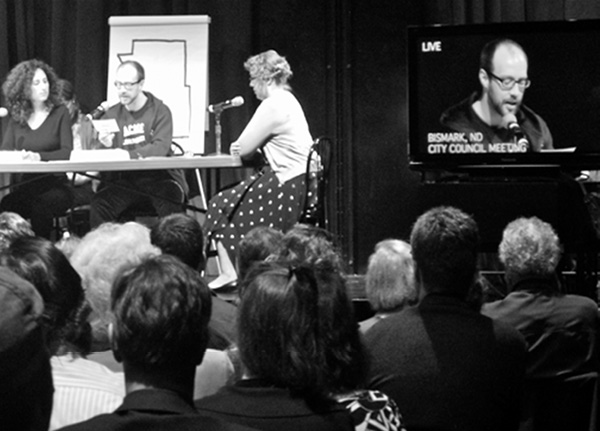
CITY COUNCIL MEETING
first performed on
January 11, 2011
HERE Arts Center, New York, NY
performed three times in 2011
AARON LANDSMAN, MALLORY CATLETT, JIM FINDLAY
New York, NY and Urbana, IL
981765274a981765274a981765274r981765274o981765274n981765274@981765274c981765274i981765274t981765274y981765274c981765274o981765274u981765274n981765274c981765274i981765274l981765274m981765274e981765274e981765274t981765274i981765274n981765274g981765274.981765274o981765274r981765274g
citycouncilmeeting.org
CITY COUNCIL MEETING
AARON LANDSMAN, MALLORY CATLETT, JIM FINDLAY
Viewers arriving at “City Council Meeting” are presented with a choice: be a Commissioner, who performs the meeting; be a Participant, who gets a testimony s/he may or may not be called on to read; be a Respondent, who gets physical instructions (send a text, stand up, leave the room, etc.); or be a Bystander, who goes to the bar and waits for the piece to start.
After orientations by “staffers,” the audience performs the meeting, an amalgam of transcripts of real council meetings from various US cities over the last couple years. A departing Commissioner makes a farewell speech about a lifesaver candy; a resolution on drainage becomes a vision of apocalyptic flooding; a Jimmy Stewart-esque man dumps a pile of crap in front of the council and asks what we’re going to do to protect the kids. The room is cleared. Your words are read into the record. And then the theater magic begins. Everything is streamed online and played over monitors in the room.
We are developing “City Council Meeting” to address several problems:
How can audience participation in theater not suck?
We give the audience rigorous instructions, so that they are both supported and kept in line. We want to find the sweet spot between hemming them in and leaving them out to dry, so they take responsibility for another person’s words, rather than try to “play a role.” Empathy and communication over representation and virtuosity.
How can the procedures of local bureaucracy become compelling and hilarious?
We are using the video and the natural offhand awkwardness of the viewers to guide us. What we find is that, at its best, we get to see the humanity of the people in the room as they try to do what we ask of them, and that is often funny, sublime, and touching in ways we never expected.
How can a piece about a fictional city we create by performing each night also be truly local?
We are creating the piece with a working group of performers and non-performers in New York and then building similar cohorts in the other cities where we’ll do the project (currently Houston, San Francisco and Tempe). Those local cohorts will help guide the way the piece molds and fits to each place. Also, the last twenty minutes of the work are created with that cohort in each city where it’s presented.